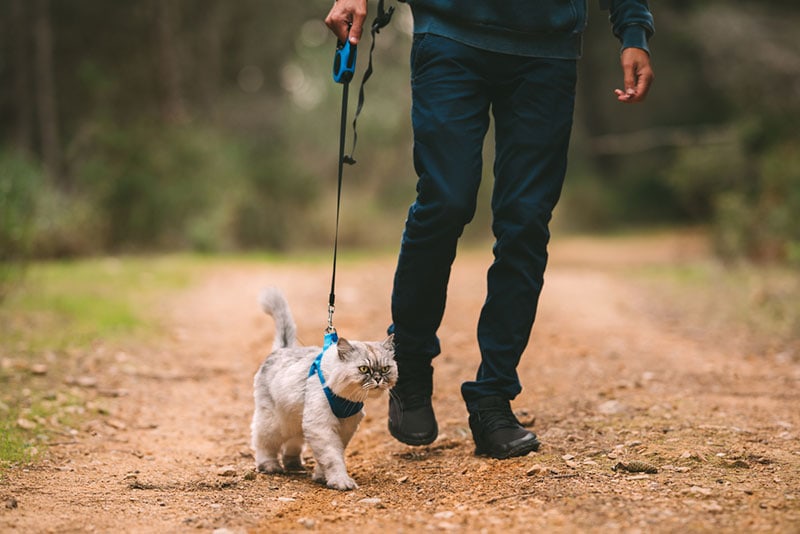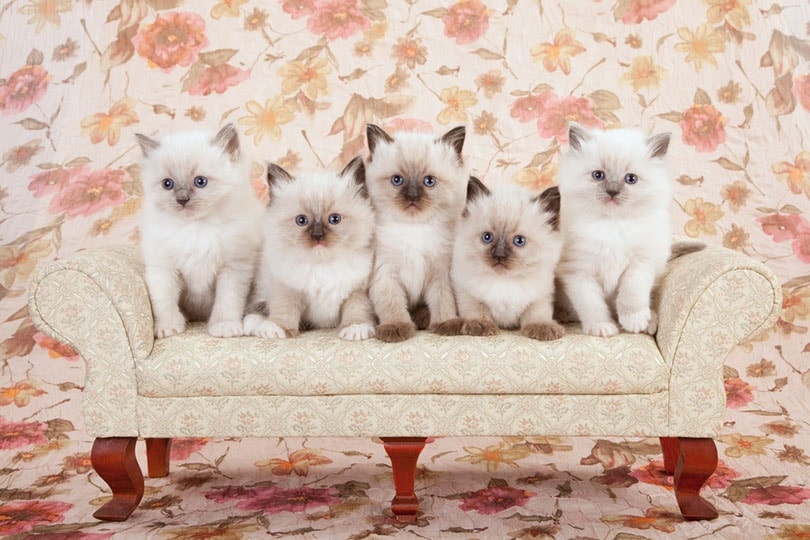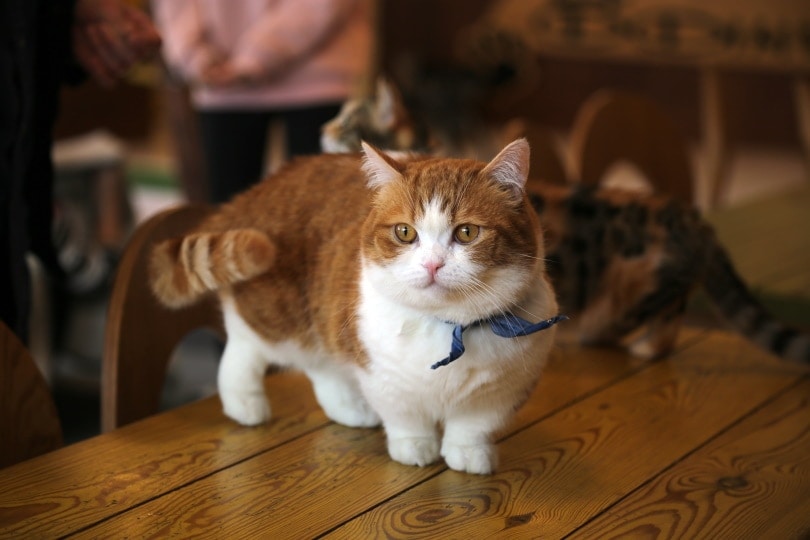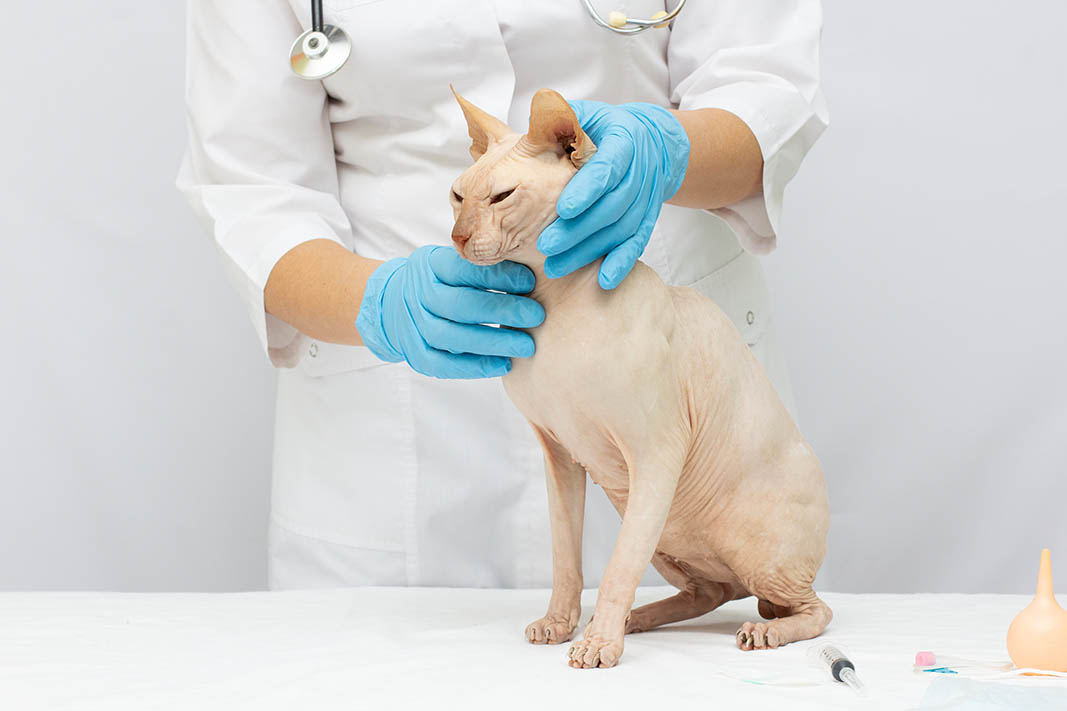Indoor vs. Outdoor Cats: Vet-Reviewed Key Differences (With Pictures)
Updated on
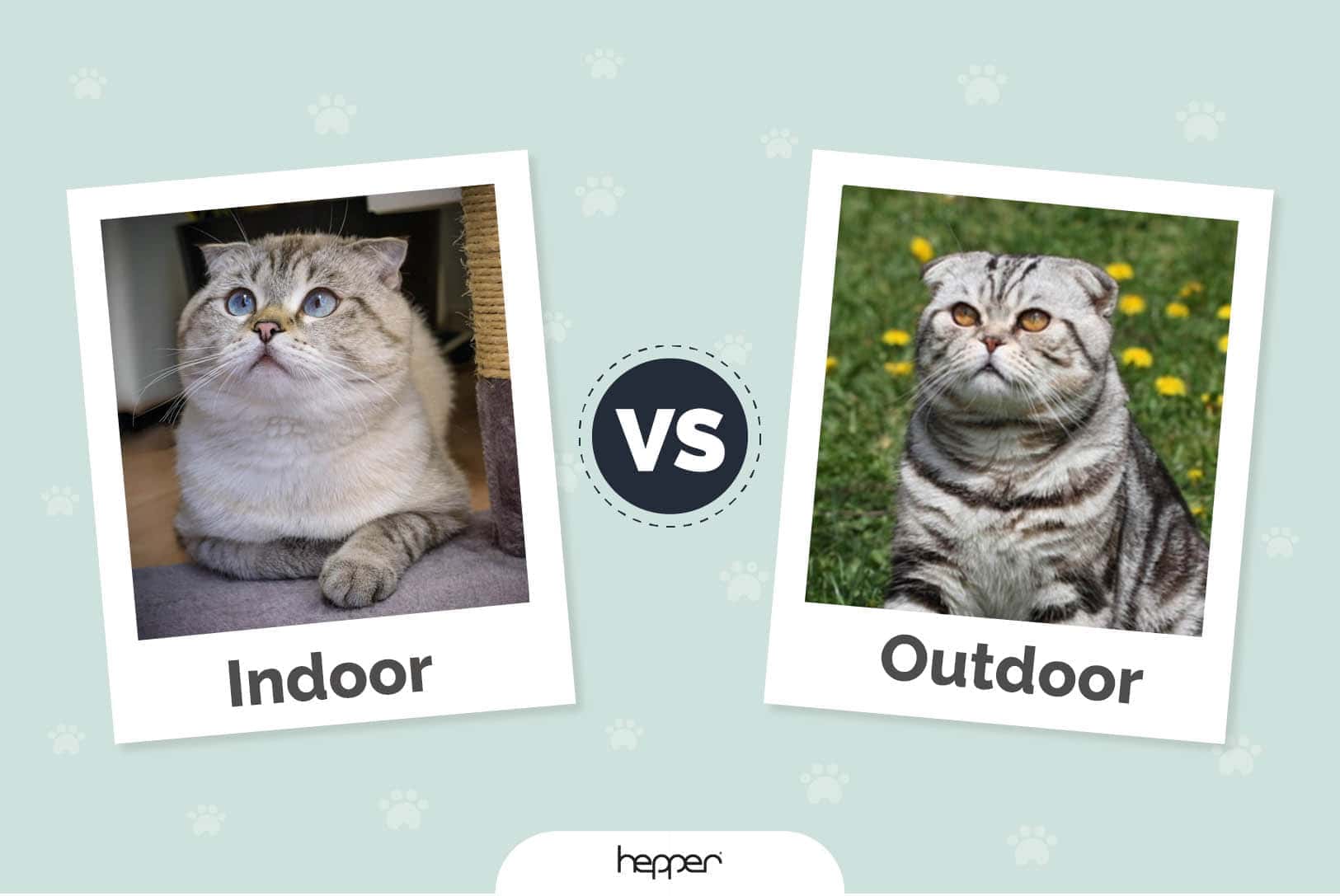
Click to Skip Ahead
It is believed that humans domesticated cats around 8,000 to 10,000 years ago, based on archaeological evidence. If you think your pet is more in touch with their wild side, you’d be right when you compare them to dogs. It only makes sense that you may think about whether you should keep your cat indoors or outdoors, especially if you don’t live in an urban area.
Both sides of the question raise some compelling evidence. That’s particularly true if you consider the species origin and the purpose it has had for humans. We’ll consider the answers from both perspectives, with facts that will cover both the pros and cons of each case.
At a Glance
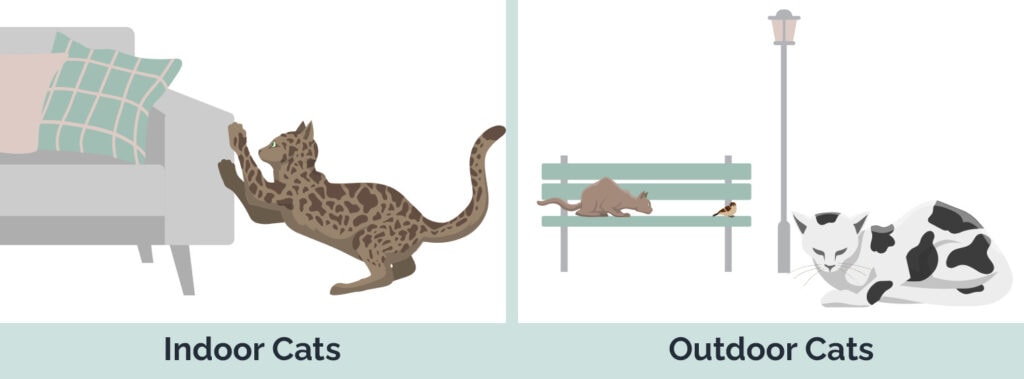
Overview of Indoor Cats
Over 45 million American households have invited a cat into their lives.1 After all, they are affectionate animals that can form strong attachments to their owners. They are fun to watch, especially as kittens, and they can make anything a toy. Perhaps one of the things that people like most about having one around the house is that they are low maintenance in comparison to dogs, although they still need a dedicated owner to care for them.
It’s not as much of a big deal to go out of town for the day. Just leave out enough food and water and get a friend to check them over once or twice a day and your cat will do just fine for a day or two. But does that mean they’re better off as indoor pets?
Cats aren’t as active all day as dogs. Some cats can sleep up to 18 hours a day!2 That makes them a good choice if you have a variable schedule. Your pet probably won’t miss you too much if you’re an hour or two late; it’s just more time for them to nap. The question of keeping your cat inside versus letting them go out often rests on several issues: the litter box, the cat’s health, weighing the risk of them getting hurt outside of the home, and the impact your cat will have on local wildlife.
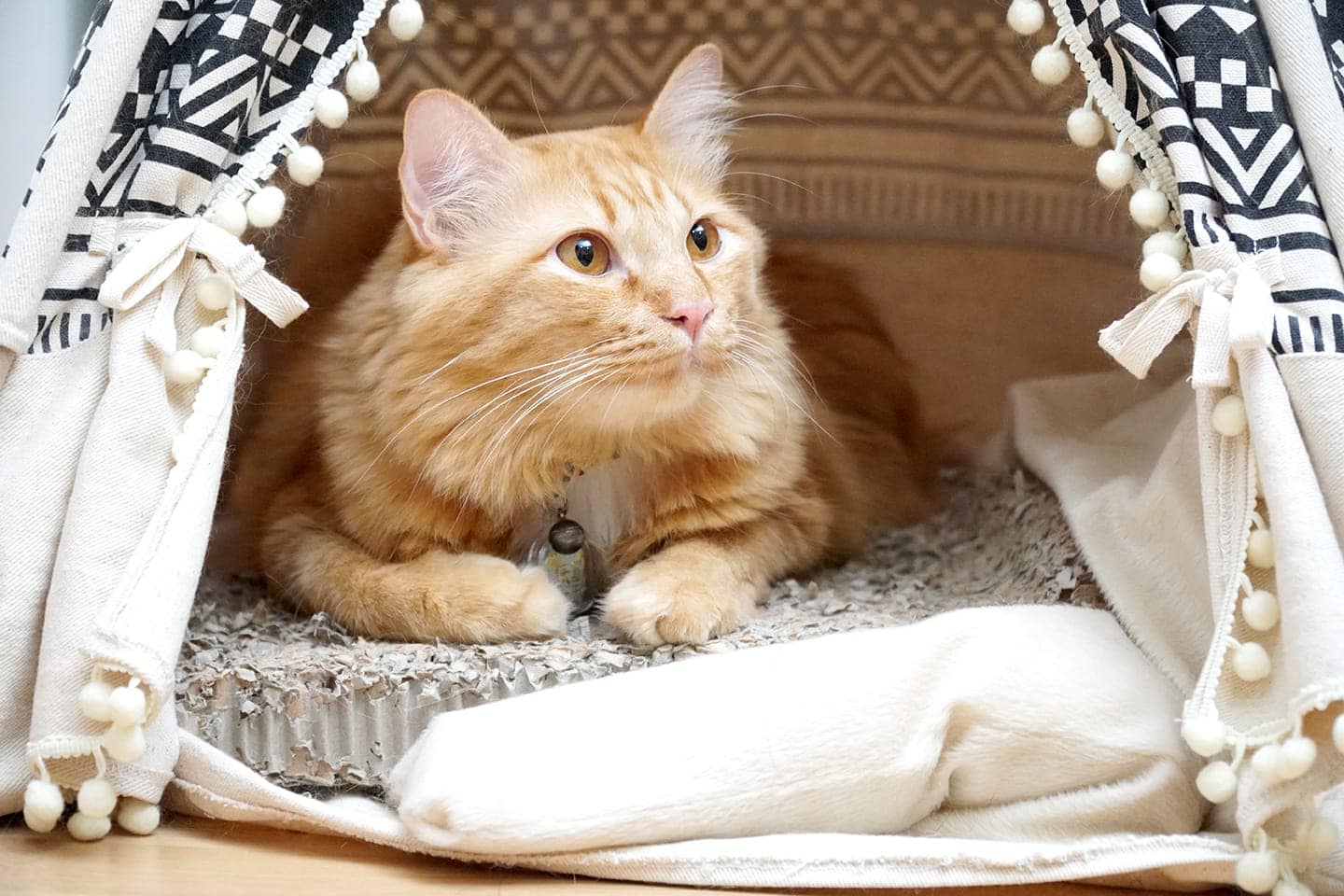
The Litter Box and Indoor Cats
Having a pet requires maintenance, no matter what animal you bring into your home. Of course, an indoor cat also means having a litter box, and that means cleaning it and dealing with the litter that you inevitably find everywhere in your house. You also must consider the cost of the litter box. After all, Americans spent $1.1 billion on litter alone in 2018.
Unfortunately, cats make cleaning the litter box unpleasant. Felines get most of their moisture from the foods—or prey—they eat, and they don’t drink a lot of water. That makes their urine highly concentrated. There are also the health risks of coming in contact with used litter, particularly toxoplasmosis. It’s a valid point, given its seriousness for pregnant women and infants. The litter box should be emptied frequently, not allowing the feces to stay there for 24 hours or more, which is the minimal time for the parasitic cysts to become infective.
On the other hand, outdoor cats don’t bring these issues to the table because the backyard is their litter box. Nevertheless, that doesn’t discount the health risks. It only means that you won’t have the task of cleaning or paying for litter, or does it? Your cat can still shed Toxoplasma in the environment, and it may be present in the grass or your vegetable garden if your cat chooses to toilet there. So, caution should always be exercised when bringing in vegetables from the garden, and these should be thoroughly washed.
Even outdoor pets should come inside during extreme weather conditions. Even if your kitty spends most of their time outside, they will probably be in the home a few times in a 24-hour period, thus still requiring a litter box.
Health Issues in Indoor Cats
An indoor cat has a better chance to live longer to the average 12–15 years, or even as long as 17 years, compared to an outdoor animal. You have a better opportunity to observe their health and eating patterns so that you can act quickly if anything is amiss. Your indoor pet is more likely to get regular veterinary care and faces fewer risks from the outdoors, some of the most common ones being road traffic accidents, diseases, and injuries from fighting with other animals.
They are solid arguments for keeping your cat inside, especially if you want to bond with your pet. That’s harder to do if they’re roaming the neighborhood every night. On the downside, felines need mental stimulation. Otherwise, they’ll find entertainment one way or another, whether that means climbing the curtains or scratching your furniture.
Cats need exercise and enrichment to stay happy and healthy, and walking them on a leash can be a great way to do both.
Cats need exercise and enrichment to stay happy and healthy, and walking them on a leash can be a great way to do both.
- Escape Proof - Cat leashes and harnesses for walking aren't all equally secure. Our double aluminium...
- Superior Comfort - Our cat harnesses are lightweight, made with premium velvet fabric, breathable...
Our Hepper Cat Harness & Leash Set combines a sturdy nylon climbing rope leash with a lightweight, highly adjustable harness. The machine-washable velvet and mesh harness is designed to be as comfortable as it is sturdy, and extra features like aluminum double D-rings, reinforced stitching, quick-release buckles, and reflective stripes make this cat walking set a great option.
- Longer lifespan
- Reduced parasite risk
- Reduced disease risk, as there’s no contact with other cats or animals
- No risk of road traffic injuries that may be fatal
- Reduced risk of getting in touch with outdoor toxins
- Better bonding experience
- Protecting the local wildlife
- Inappropriate scratching or toileting
- Boredom
- Frustration
- Other behavioral issues
- Exposure to indoor toxins possible
- Reduced activity
- Possible higher predisposition for obesity
Overview of Outdoor Cats
An outdoor cat may fit in better with some people’s idea of having this pet in their home. They can spend some or most of their time outdoors. Some owners give them the chance to decide what their cats want with the installation of pet doors. It might take a few tries for your kitty to learn how to use it. However, once they do, your pet has total freedom to decide what they want to do.
The issue with these products is that other animals may take advantage of them. The solution is a microchip cat flap or a special door that only allows access to your cat, as it reads their microchip number. If you live in an area with lots of wildlife, that’s an excellent choice for not only keeping the raccoons and skunks outside of your house but also other stray cats and cats from the neighborhood. Some types of cat flaps also work by connecting to a device that is attached to a cat’s collar. The problem is getting your cat to wear a collar. However, a microchip is a smart option to identify your pet in case they get lost.
A pet door limits you in having to get your cat in and out, which we can surmise would get annoying at times. Persistence is a strong suit of any feline. However, that only scratches the surface of the things you need to consider on the outdoor cat front.
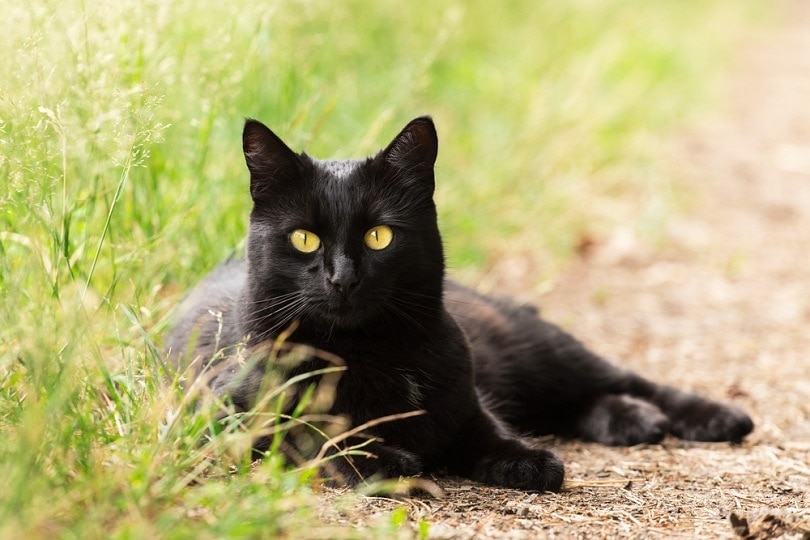
The Effect of Outdoor Cats on Birds and Small Mammals
Cats, both domestic and feral, have received a heap load of criticism for the toll they take on songbirds. That’s especially true if your neighbors have feeders or nest boxes in their yard. Felines are hunters and will take advantage of this low-hanging fruit. Some estimates put the number at almost 4 billion birds and up to 22 billion small mammals! They may even have contributed to the extinction of 87 different bird species.
Some experts have labeled cats as the single most dangerous non-invasive species to birds, and this data is worth noting. Birds contribute to the functioning of healthy ecosystems, the food web, seed dispersal, and the overall biodiversity of the planet. Part of the responsibility also lies on the human population and animal abandonment, which has led to high numbers of stray and feral cats and their uncontrolled reproduction.
Hunting is instinctive behavior for cats and something humans have encouraged during the domestication process for rodent control, but unfortunately, it has now gotten out of control, leading to severe impact on local wildlife. This alone is a good argument to consider keeping your cat indoors or to provide them with a safe outdoor environment, such as a catio, where they can exhibit their normal behavior but not have a devastating impact on birds and small mammals and compromise your relationships with birdwatchers in your neighborhood.
Health Issues in Outdoor Cats
The other concern we must address is the health of an outdoor or indoor/outdoor cat. It’s true that they can find mental stimulation being outside that is hard to replicate inside the house. They are less likely to have issues with the litter box, frustration, and inappropriate urination. However, these benefits are far outweighed by the added risks these pets have.
Outdoor cats are more likely to suffer injuries from other predators, such as coyotes and dogs. They can accidentally stumble upon other hazards, like poisons, traps, and other potential problems. Unfortunately, that can also include people who don’t like cats and will go out of their way to harm them, or they may get stolen.
We also must consider the risks to you and your family. An outdoor cat that hunts is more likely to get infected with parasites, such as fleas and roundworms. The latter is more of an issue if your pet hunts rodents. The problem is that they are zoonotic or transferable to people, including your kids.
An outdoor cat also needs a different approach to their regular vaccinations to protect them against diseases they wouldn’t really encounter as indoor pets. Some of these illnesses cannot be entirely prevented, as either there is no available vaccine or it isn’t very efficient, as many viruses will mutate.
Outdoor cats are at risk of contracting feline chlamydiosis, feline coronavirus, feline immunodeficiency, and feline leukemia, among others, often transferred between cats through fighting and mating. The only way to reduce exposure to these is to get your cat neutered and keep them indoors and up to date with their vaccinations based on your vet’s advice and risk factors. But be mindful that indoor cats in a multi-cat household may also be at increased risk of contracting infectious disease.
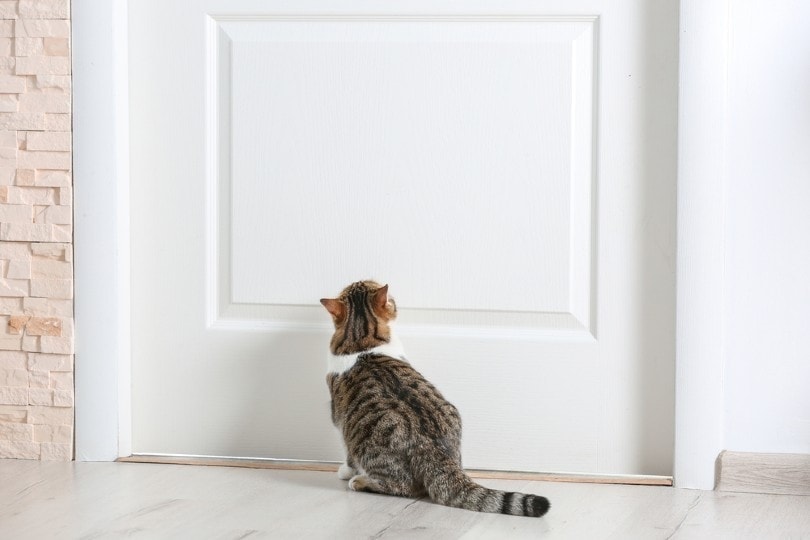
- Ability to exhibit normal behaviors
- Physical exercise
- Mental stimulation
- Shorter lifespan
- Increased risk of disease, injury, and death
- Severe and detrimental impact on local wildlife
 Other Factors to Consider
Other Factors to Consider
Cat Litter Cost
We talked about the litter in our earlier discussion. We can also consider the costs of pet ownership. You can easily expect to pay at least $20 a month for litter, depending on the number of cats and type of litter that you use. There are also the accessories, such as deodorants and liners, you might also consider. Of course, pet ownership isn’t cheap. It’s something you must think about before you make this decision.
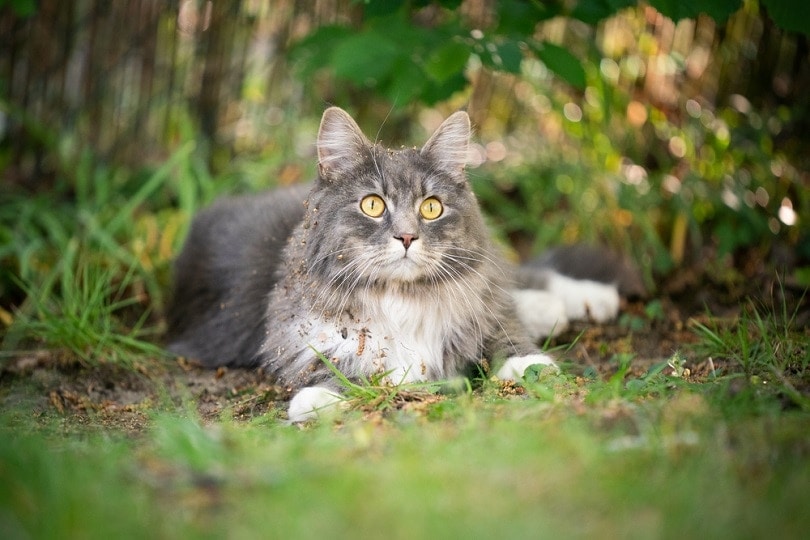
Care and Trimming of the Claws
Another thing that may cross your mind is trimming the claws, particularly if your pet is a part-time outdoor cat. A feline’s claws are their prime defense. Unfortunately, it hits a roadblock when it comes to your furniture. It’s essential to remember that it’s instinctive behavior, and they are doing what comes naturally to them.
Ask your vet to show you if your cat’s claws need trimming and how to trim cat’s claws safely, as this may be required if your indoor cat’s claws are getting long despite having a scratching post. Outdoor cats generally do not need their claws trimmed.
However, it’s worth noting that some people misinterpret trimming the claws for declawing. Declawing is a surgical procedure where the claw is fully removed, as well as the part or the whole toe that carries it (with the bone), which is an equivalent of our very top knuckle that ends with a nail. Both the American Veterinary Medical Association and the Cat Fanciers’ Association have made public stances against declawing, as the procedure carries certain risks and may cause pain and ongoing issues in cats, and the only reason they are performed in this case would be to stop cat scratching, which is not ethically justified. There are many ways to reduce cat scratching by providing cat scratching posts, plenty of physical and mental stimulation, and by regularly trimming the claws. But an outdoor pet needs their claws—all of them.
Internal and External Parasites
Parasites are an issue whether your cat is an indoor or outdoor pet. The former can still get fleas and ticks if you go outdoors. Of course, the risk is greater for outdoor animals. The same adage holds true for internal parasites. It’s an essential consideration if you have children or immune-compromised individuals in your household.
- Longer lifespan
- Reduced risk of infectious disease or trauma
- No harmful effect on local wildlife
- Litter costs
- Possible predisposition for obesity, reduced physical activity, or frustration
- Shorter lifespan
- Greater risk of disease and injury, or getting lost/stolen
- Severe impact on birds and small mammal population and diversity
- Higher healthcare costs
Final Thoughts
Given the cat’s history, it’s worth considering whether to keep your pet inside or outside. After all, they are predators that haven’t lost that connection to their past. After weighing the risks and benefits of both sides of the story, we recommend keeping your pet inside the house, if just for the fact that you can have more time with your kitty. And isn’t that why you want to get a cat in the first place?
See also:
- Tortoiseshell Cat vs Calico Cat: Coat Patterns Explained
- Can an Outdoor Cat Become an Indoor Cat? 4 Tips For a Safe Transition
Featured Image Credit: (L) Gundula Vogel, Pixabay (R) Maleo, Shutterstock



 Other Factors to Consider
Other Factors to Consider
